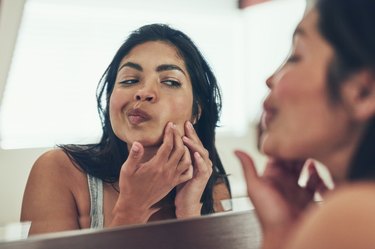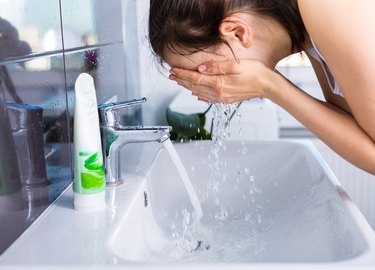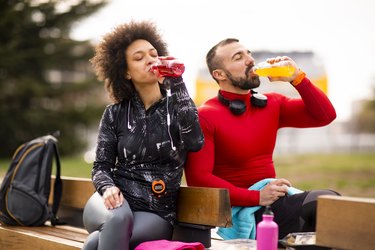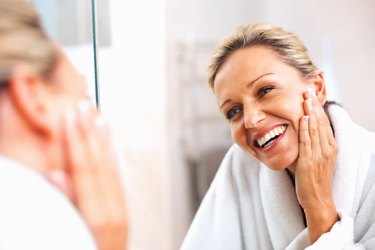
You may already know that exercise wields a huge influence on your wellbeing, from improving cardiovascular health to strengthening bones and muscles to boosting brainpower. But it might come as a surprise to discover that a sweat session also has a pretty significant affect on your skin — for better and worse.
Here, dermatologists describe exactly what happens to your largest organ (yep, you read that right) when you're getting your fitness fix — plus skin-care tips to minimize the unwanted side effects of exercise on your skin.
Video of the Day
Video of the Day
1. It Can Make Rosacea Worse
When you sweat it out at the gym, your blood vessels widen — a process called vasodilation.
"This increased blood flow ups the supply of oxygen to your skin and nourishes skin cells by carrying nutrients to repair damage from the sun and environment," says Sonya Johnson, MD, dermatologist and CEO of Dermatology Associates, PC.
Not only will your face look brighter, but that surge of hemoglobin gives you a rosy glow that can last up to two hours, according to the book Skeletal Muscle Circulation.
But for those with rosacea, vasodilation has a flip side: It triggers inflammation, which, along with increased body temperature, can worsen the condition.
The fix: “Keep a cool cloth nearby to apply to your face to keep from overheating,” suggests Sonia Batra, MD, assistant professor of dermatology at University of Southern California and cohost of The Doctors.
2. Sweat May Clog Your Hair Follicles
Perspiration cools you down and pushes toxic free radicals (compounds linked to aging and disease) out of your body via your pores — all good things — but it can also irritate your skin.
"It can clog sweat glands and body hair follicles, resulting in an acne-like eruption called folliculitis," says Robin Evans, MD, a board-certified dermatologist and clinical instructor of dermatology at the Albert Einstein School of Medicine. "Folliculitis can occur anywhere that is sweaty, especially areas of occlusion like the back and chest."
Dr. Batra points out that those spots also have a higher concentration of sebaceous glands that can become blocked when sweat and dirt dry on your skin's surface. Enter: backne, buttne and boobne.
"Eczema can also be exacerbated by sweat, which breaks down the skin barrier and can worsen itching," Dr. Batra says.
The fix: Wear loose clothing when you’re working up a sweat. According to the American Academy of Dermatology (AAD), form-fitting gear can aggravate folliculitis. Shower right afterward with warm water to remove perspiration, followed by a gentle moisturizer to restore the skin’s barrier.

3. It Can Cause Acne Flares
Plugged hair follicles can also trigger blackheads or whiteheads, which might become inflamed or infected and turn into acne, Dr. Evans says.
The fix: To buffer yourself against a zit attack, take off your makeup pre-workout. The polling firm CivicScience found in 2019 that 25 percent of women wear it while exercising. “Not only does it clog your glands and hair follicles even more, but it’s often contaminated with bacteria, which can aggravate the skin and lead to breakouts,” Dr. Evans says.
Even if you're makeup-free, it's still best to wash your face first. "Dirt and oil build up on your skin, and you want to remove that," says Debra Jaliman, MD, a dermatologist, professor of dermatology at the Icahn School of Medicine at Mount Sinai and author of Skin Rules. "Use face wipes if you're short on time — they don't require water or soap."
Then, if you have a blemish you want to hide, dot on concealer or smooth on a tinted moisturizer instead of coating your face in foundation. "A tinted BB or CC cream adds that hint of color and gives you a glowy look but is usually very light," Dr. Jaliman says.
"You need adequate fluids and electrolytes to ensure proper skin functioning. If your face looks pale or your lips feel dry, that's a sign your moisture level is low."
4. Sweating — and Using Sweaty Equipment — Changes Your Microbiome
Everyone's buzzing about gut flora these days, but did you know that your skin also has a microbiome?
"The skin microbiome is an ecosystem of organisms living on your skin, including bacteria, viruses and fungi," Dr. Batra says. "A healthy microbiome protects skin against infection and maintains a strong barrier between your body and external elements."
Exercise-induced sweat can disturb that sensitive microbiome. "Certain organisms, such as yeast, thrive in a moist environment," Dr. Batra says. "Allowing sweat to remain on the skin for a long period of time often shifts the balance of the microbiome and allows yeast to overgrow." That can lead to an itchy, scaly rash on your face and torso, plus dandruff.
And speaking of germs, a hot, humid gym is an ideal bacteria breeding ground. A December 2014 study in the International Journal of Environmental and Public Health found an "alarming" degree of bacteria on equipment like free weights, exercise machines and mats. In 2017, research by the website FitRated — which tests and rates popular fitness equipment — tested 27 pieces of equipment from three different gyms and discovered that it contained significantly more germs than a cafeteria tray, toilet seat and faucet knobs—and 70 percent of it was potentially harmful to humans.
Read more: 7 Weird Side Effects of an Unhealthy Gut
The upshot: Every time you put your hands on a yoga mat or cardio machine and then touch your face, you're spreading bacteria across your complexion.
The fix: Dr. Evans suggests bringing your own mat and spraying it down with a cleaner after activity, such as a spray bottle filled with rubbing alcohol. Many gyms also offer wipes to keep germs at bay. Hop in the shower as soon as you can, too, and consider sudsing up with a microbiome-friendly wash, like Mother Dirt’s Biome-Friendly Foaming Cleanser. It’s chock-full of ammonia-oxidizing bacteria (AOB), a “good bacteria” that converts irritating compounds in our sweat, like ammonia and urea, into skin-soothing nitrate and nitrous oxide. In a small-but-encouraging study of 24 people presented in September 2014 by the American Society for Microbiology, those who applied AOB to their face reported better skin condition and appearance than a control group.

5. It Can Dry Out Your Skin
When you sweat, your body loses moisture — including from your skin. Al fresco workouts pack a double punch because sun exposure also zaps hydration.
"You need adequate fluids and electrolytes to ensure proper skin functioning," Dr. Evans says. "If your face looks pale or your lips feel dry, that's a sign your moisture level is low."
The fix: Grab a bottle of coconut water or a sports drink, and snack on an energy bar or a banana. If you’re outside, remember to slather on SPF. “Sunscreen that contains titanium dioxide and zinc will give you the best broad-spectrum protection,” Dr. Evans says. “Avoid products containing mineral oil or glycerin, which can clog your pores.” Sun-protective workout clothes can also shield you from harmful rays. The Skin Cancer Foundation recommends items with a UPF rating of at least 50.
6. It Might Give You Thigh Chafe
Chub rub making workouts uncomfortable?
"Repeated rubbing or exposure to moisture or irritating fabrics can break down skin cells, leading to a rash that may sting or burn," Dr. Batra says.
The fix: “Apply antiperspirant to areas of your body that sweat a lot, and lubrication — such as creams, oils or powders — wherever there’s friction,” Dr. Batra recommends. Also, stick to moisture-wicking clothing that let perspiration evaporate, instead of materials like cotton that hold onto sweat and keep your skin damp.

One Big Benefit: It May Make Your Face Look Younger
Collagen is a protein found in connective tissue that helps make your skin firm, full and smooth. But as you age, your collagen levels drop off, according to the AAD, causing lines and sagging.
The good news: You can partly reverse that process by getting your cardio on. "Fibroblasts are cells that produce collagen," Dr. Johnson says. "When you exercise, fibroblast activity increases, generating more collagen." Hello, bouncy, dewy skin.
And the benefits don't stop there. As you grow older, your top layer of skin becomes thicker, rougher, and drier. At the same time, the deeper skin layers thin by about 6.4 percent each decade, leading to drooping and wrinkles — particularly in the face, neck, chest, hands and forearms, according to a February 2013 review in the journal Advances in Wound Care.
Consider exercise your anti-aging elixir: Research featured in the journals Aging Cell in August 2015 revealed that working out can make your face look years younger.
"Exercise stimulates substances called myokines — specifically interleukin-15, which increases the thickness of the deeper layers of the skin and decreases the thickness of the outer layers," Dr. Jaliman says. The result? A smoother, brighter, more baby-faced complexion. Yes, please!
Read more: 21 Anti-Aging Foods
- Skeletal Muscle Circulation: "Chapter 4: Exercise Hyperemia and Regulation of Tissue Oxygenation During Muscular Activity"
- American Academy of Dermatology: "Acne-Like Breakouts Could Be Folliculitis"
- CivicScience: "Sneakers? Check. Mascara? Check. Makeup is the New Workout Gear"
- International Journal of Environmental and Public Health: "Diversity of Bacterial Communities of Fitness Center Surfaces in a U.S. Metropolitan Area"
- FitRated: "Study: Examining Gym Cleanliness"
- American Society for Microbiology: "Sweat-eating bacteria may improve skin health"
- Skin Cancer Foundation: "Sun-Protective Clothing"
- American Academy of Dermatology: "Skin Care Secrets"
- Advances in Wound Care: "Characteristics of the Aging Skin"
- Aging Cell: "Exercise-stimulated interleukin-15 is controlled by AMPK and regulates skin metabolism and aging"
Is this an emergency? If you are experiencing serious medical symptoms, please see the National Library of Medicine’s list of signs you need emergency medical attention or call 911.